Telling Stories in Cowan
Rare book collectors gather for the third annual Tennessee Antiquarian Book Fair
Jim Presgraves grew up in rural Virginia and, as a young boy, never gave books much thought until the day he found himself at a country auction with fifteen cents in his pocket. On the auction block was an oil-burning oven—a device his family could use. Inside the oven, strangely enough, was a book. Jim bid ten cents but was quickly outbid at fifteen cents. Afterward he approached the high bidder to ask whether she had been bidding on the oven or the book. The woman admitted that she could neither read nor write and kindly gave the book to young Jim, who took it home and showed it to his father. It turned out to be a history of a local Civil War unit, and his father quickly sold the volume to a friend for twenty-five dollars. A lifelong buyer and seller of books was born that day. Now the white-bearded owner of Bookworm & Silverfish in Wytheville, Virginia, Presgraves stood just outside his book-crowded booth at the Tennessee Antiquarian Book Fair as he delivered the punchline to his story: “My family says I never looked back. Other vendors say I still demand the same rate of return on my investments!”
On a sunny July day in the tiny town of Cowan, Tennessee, (population: 1,700), forty-nine booksellers from twelve states and Canada recently gathered to buy, sell, and trade at the third annual Tennessee Antiquarian Book Fair, sponsored by the Tennessee Antiquarian Booksellers’ Association, or TENNABA. Association president Tom McGee, a Cowan resident and owner of local bookstore The Book Brake, described the event as “the only major antiquarian book fair in America that takes place in a small town.” Cowan was settled in 1852 as a station for the Nashville and Chattanooga Railroad, but has been economically depressed since the railroad’s passenger service ended in 1972. Local points of interest include the Railroad Museum, which is located in the original town depot and listed on the National Register of Historic Places, and nearby Cumberland Mountain tunnel. This 2,200-foot-long railroad tunnel, which is still in use today, took three hundred men working with picks and shovels three years to complete and was the longest tunnel in the world at the time of its completion in 1851.
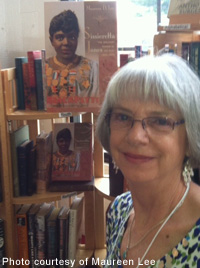 While the yearly book fair has been a healthy boon to the town’s economy, Cowan might seem an unlikely location for such an event. McGee explained that the town’s central location—within a few hours of large cities like Atlanta, Nashville, Birmingham, and Knoxville—and its proximity to the University of the South at Sewanee, make it an attractive stop for vendors, who appreciate that TENNABA keeps the exhibition fees very low. According to its mission statement, the purpose of TENNABA, in part, is “to engender public awareness of the value of printed books and ephemera as vital records of civilization, as tangible links to great minds of the past and present, and as great works of art.”
While the yearly book fair has been a healthy boon to the town’s economy, Cowan might seem an unlikely location for such an event. McGee explained that the town’s central location—within a few hours of large cities like Atlanta, Nashville, Birmingham, and Knoxville—and its proximity to the University of the South at Sewanee, make it an attractive stop for vendors, who appreciate that TENNABA keeps the exhibition fees very low. According to its mission statement, the purpose of TENNABA, in part, is “to engender public awareness of the value of printed books and ephemera as vital records of civilization, as tangible links to great minds of the past and present, and as great works of art.”
Over at the booth of First Folio Rare Books (Paris, Tennessee), great works of art were definitely on display. Owners Dennis Melhouse and Dennis Hatman opened a glass case and pulled out one wonder after another, each object more fascinating and exquisite than the one before. Several volumes featured fore-edge painting, in which an artist takes a printed book, turns it sideways with the fore-edge (or area opposite the spine) facing forward, fans the pages slightly and paints a work of art, often a landscape or portrait, that disappears when the book is closed. One book featured a double fore-edge painting, in which the pages fanned in one direction produce a painting, and when the book is turned over and the pages fanned in the opposite direction, a completely different painting is revealed.
Also in the glass case at First Folio’s booth was a special edition of Select Fables, published in 1820 by master engravers Thomas and John Bewick—a valuable book ordinarily, but this particular copy was far from ordinary. Bound in Moroccan leather and extensively decorated with insets, overlays, and heavy gilding in designs styled after the authors’ original engravings, the book’s front and back covers were inlaid with garnets and turquoise and the flyleaves made of snakeskin. Finally the proprietors pointed out A Selection from the Works of Alfred Tennyson published in 1865, the cover of which was highlighted by a delicate and lovely miniature painting of Tennyson executed on ivory by Miss C. B. Currie, one of the foremost miniaturists of the time.
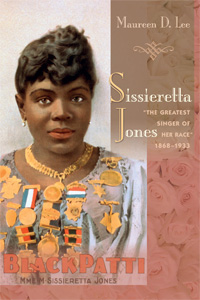 Michael Slicker of Lighthouse Books (St. Petersburg, Florida)—who identified his favorite childhood book as the chivalric tale Otto of the Silver Hand by Howard Pyle—exhibited one of the most valuable items at the fair: the three-volume set of The History of Indian Tribes of North American, a collection of 120 hand-colored lithographs depicting vividly detailed portraits of Native American leaders who traveled to Washington D.C. in the early nineteenth century to negotiate treaty terms with the U.S. government. Originally commissioned as oil paintings, the limited-edition lithograph series, sold by subscription, became even more precious after most of the paintings were lost in a fire at the Smithsonian in 1865. Slicker’s copy was priced at $17,500.
Michael Slicker of Lighthouse Books (St. Petersburg, Florida)—who identified his favorite childhood book as the chivalric tale Otto of the Silver Hand by Howard Pyle—exhibited one of the most valuable items at the fair: the three-volume set of The History of Indian Tribes of North American, a collection of 120 hand-colored lithographs depicting vividly detailed portraits of Native American leaders who traveled to Washington D.C. in the early nineteenth century to negotiate treaty terms with the U.S. government. Originally commissioned as oil paintings, the limited-edition lithograph series, sold by subscription, became even more precious after most of the paintings were lost in a fire at the Smithsonian in 1865. Slicker’s copy was priced at $17,500.
At the same booth was a beautiful first edition of Mark Twain’s Huckleberry Finn. Slicker pointed out that the original page 283 had been replaced in this copy, which is one of the identifying points designating a first edition. In 1885, during the original U.S. printing of 30,000 copies, an unidentified engraver took some high-spirited liberties with the illustration of Silas Phelps that appears on that page. Liberties involving the fly of his trousers. Once the infraction was discovered, new copies of the corrected page were made and substituted into the already printed but not yet released copies. (It was too late to recall the salesman samples of the novel, but sales agents were directed to tear the offending page out of their copies and return it to the publisher or suffer termination.)
Providing an international aspect to the fair this year was the booth of Wilfrid M. de Freitas of Montreal. When asked which book made him fall in love with books, de Freitas responded dryly, “I don’t know when the rot set in.” Items of interest in his booth included two six-volume sets of The Second World War by Winston Churchill. Demonstrating the value a signature can add, the unsigned set was priced at $400 while the autographed set was tagged $6,000.
Why so much more for a signature? It’s about connection. When a reader holds a signed copy of a favorite book, it is impossible not to imagine the author holding it as well. Suddenly a line stretches directly between you and the distant past—another time, another place, the writer’s head bent over the clean white page, the pen scratching away. It’s also one reason why first printings of first editions are the most collectible of all copies. Booksellers describe them as the copies “closest to the author.”
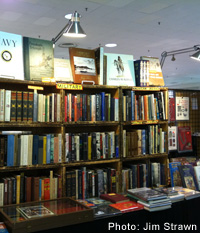 Another highlight of this booth was a 1684 pre-nuptial legal contract, or “indenture,” written on vellum and originating from Nottingham, England. The purpose of the contract was to settle property on a newly married couple by the groom’s parents. The contract was signed and sealed by not only the father and son, but also the mother and daughter-in-law, which was very unusual for the time. The wavy-edged top of the document would have matched perfectly to a copy produced at the same time, thus proving both documents’ authenticity.
Another highlight of this booth was a 1684 pre-nuptial legal contract, or “indenture,” written on vellum and originating from Nottingham, England. The purpose of the contract was to settle property on a newly married couple by the groom’s parents. The contract was signed and sealed by not only the father and son, but also the mother and daughter-in-law, which was very unusual for the time. The wavy-edged top of the document would have matched perfectly to a copy produced at the same time, thus proving both documents’ authenticity.
Most of the booksellers were happy to tell the story of how they came to collect rare books. Gary Overmann of Books of the Ages (Batavia, Ohio), specializes in children’s books, with a particular interest in classic illustrators like Arthur Rackham and Tasha Tudor. Rackham’s artwork is what first drew Overmann to collecting, and Tudor eventually became a customer, as well as a personal friend who would autograph copies of her books for Overmann’s children. On this day, his affable nature and a background in chemistry prompted him to offer one browser advice about how best to remove an unfortunately placed sticker from her own older book’s fragile cover.
A number of speakers were featured throughout the two-day fair, including authors of recently released Civil War histories, children’s books, and science fiction. First-time author Maureen Donnelly Lee was preparing to retire from her job at Clemson University in 2003 when she visited family in Providence, Rhode Island, and was struck by a photo of African-American soprano Sissieretta Jones in a museum exhibit on Rhode Island treasures. “I was just taken,” Lee explained, “I thought she was so beautiful.” After nine years of travel, research, and writing, Lee completed Sissieretta Jones: “The Greatest Singer of Her Race,” 1868-1933. Before Lee’s book was published, not much had been written about Jones, one of the first African-Americans to perform at Carnegie Hall, and Lee and her husband spent years poring over microfilm of two African-American newspapers—The Indianapolis Freeman and The New York Age—between the years of 1885 and 1914, searching the entertainment pages for any mention of her concerts or, most excitingly, the occasional interview.
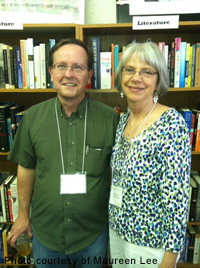 With that information and other bits and pieces, including a scrapbook housed at Howard University, Lee was eventually able to create a timeline of the singer’s life. Although Jones was one of the highest paid performers of her era and traveled all over the world, no recordings of her voice are known to exist, and she has been all but forgotten. Lee hopes her book will change that and has worked in conjunction with the Black Heritage Society in Providence to have a historical marker erected near the site of Jones’s former home close to Brown University.
With that information and other bits and pieces, including a scrapbook housed at Howard University, Lee was eventually able to create a timeline of the singer’s life. Although Jones was one of the highest paid performers of her era and traveled all over the world, no recordings of her voice are known to exist, and she has been all but forgotten. Lee hopes her book will change that and has worked in conjunction with the Black Heritage Society in Providence to have a historical marker erected near the site of Jones’s former home close to Brown University.
Jim Strawn, manager of the Georgia Fine and Collectible Book Fair and owner of Smythe Books (Dunwoody, Georgia) presented “Book Collecting 101,” a talk filled with free advice for the novice collector. “No matter your budget or experience,” Strawn advised, “it’s a good time to start collecting. Think about what you like—whether it be an author or a subject. For me, it was C.S. Lewis.” In the early 1980s, Strawn read Lewis’s Mere Christianity and not long after had a chance to visit England. He decided to learn a little more about Lewis and visited Oxford University, where he happened upon a local book fair and struck up a lifelong friendship with one of the vendors.
As a result of this encounter, Strawn began to buy and sell the books he loved, branching out to Lewis’s friends J.R.R. Tolkien and Charles Williams, and to writers who influenced Lewis, like George MacDonald and G.K. Chesterton. Strawn explained, “You are gathering books related to something that you enjoy. It is about the love, and it really is a passion.” Strawn’s own most memorable find was a first edition of J.D. Salinger’s Franny and Zooey that featured a full-page inscription by the famously reclusive author to a close friend. Strawn sold the book for $25,000. Of course, book condition plays a huge part in determining value. Strawn suggested that what collectors really hope to find are examples so pristine “they look like they’ve been kept in a sock drawer for the last thirty years!”
George E. Webb Jr. is the proprietor of Tennessee Books and Autographs (Rogersville, Tennessee) and the only dealer at the fair specializing in books about Tennessee history, autographs of famous Tennesseans, and ephemera such as pamphlets, broadsides, maps, manuscripts, and photographs related to the state. Webb is one of the few booksellers who continue to print and mail catalogs and newsletters to customers rather than rely on emails and websites. Recent catalog offerings included a broadside priced at $950 advertising the sale of “Condemned Stock: 200 U.S. Horses and Mules recently belonging to the 12th Kentucky Cavalry, now dismounted” being offered for sale at Sweetwater, Tennessee, in 1865.
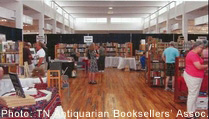 Perennially popular autographs, according to Webb, are those of Davy Crockett, John Sevier, William Blount, Alvin York, and the three Tennessee presidents: Jackson, Johnson, and Polk. Local residents visiting Webb’s booth were excited to see a large panoramic photograph taken in Cowan in 1946 of the scores of employees of the General Shoe Company—later Genesco—assembled directly in front of the former manufacturing facility, which happened to be the same building—completely renovated—housing the book fair at the moment.
Perennially popular autographs, according to Webb, are those of Davy Crockett, John Sevier, William Blount, Alvin York, and the three Tennessee presidents: Jackson, Johnson, and Polk. Local residents visiting Webb’s booth were excited to see a large panoramic photograph taken in Cowan in 1946 of the scores of employees of the General Shoe Company—later Genesco—assembled directly in front of the former manufacturing facility, which happened to be the same building—completely renovated—housing the book fair at the moment.
Webb’s low-tech approach was the exception. Most of the exhibitors at the Tennessee Antiquarian Book Fair seemed to consider the Internet a helpful tool, despite its tendency to disseminate inaccurate information—especially overblown prices. Regarding the proliferation of electronic readers and ebooks, book fair organizer McGee was philosophical. “Anything that encourages people to read is always a good thing,” he said. “As far as long-term impact, I think electronic readers are here to stay, but there’s something about the feel of a book, especially an older book, that will never be as tangible with an e-book. And when you buy a used book or a new book, it’s something that has value. You can resell it, or you can trade it. That’s not quite as easy with an ebook.”
According to McGee, ebooks affect the sale of mass-market and trade paperbacks far more than the more collectible hardcovers. “What often happens is that a person will read a book on an electronic reader and then say, ‘I’d like to have that in my personal library.’ Of course, lower print runs mean that books are going to become more scarce. A hundred years ago in this country, to have a nice library in your home was a sign of great wealth. Today anyone can put together a home library, but I believe that within the next thirty years having a nice library of hardcover books will once again be perceived as a demonstration of wealth.”
Late in the day, a final walk around the facility brought to light two more treasures that succinctly illustrated the diversity of the world of book collecting, either of which might be had by the discriminating collector for a mere $5,000. The first: an autographed copy of Harry Potter and the Deathly Hallows. The second: an official government document signed by Abraham Lincoln. Whether more intrigued by former presidents or boy wizards, curious shoppers at the Tennessee Antiquarian Book Fair who stopped to pick up a book or document or peer at a photograph or illustration were (whether they realized it or not) surrounded by ghosts—of workers in a shoe factory, an unsung African-American singer, Silas Phelps’s pants and Winston Churchill’s war, Native Americans in search of freedom, a newly married couple in seventeenth century Britain. Ultimately, it’s their stories—both real and imagined—that educate, entertain, enlighten, and enthrall, and whether handwritten on vellum, printed with hot lead, painted on ivory, or digitized on a screen, as long as there are readers, their stories will continue to be told.
To find out more about the Tennessee Antiquarian Book Fair, click here. If you can’t wait until next summer’s book fair in Cowan, check out the Georgia Fine and Collectible Book Fair in Marietta, Georgia, September 22-23. Many of the vendors in Cowan also plan to attend this event.


